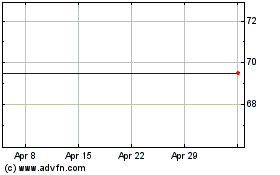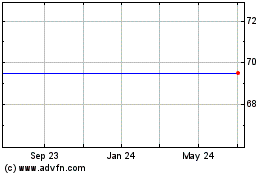Ball to Close Quebec Food Can Plant
May 25 2005 - 9:30AM
PR Newswire (US)
Ball to Close Quebec Food Can Plant BROOMFIELD, Colo., May 25
/PRNewswire-FirstCall/ -- Ball Corporation (NYSE:BLL) announced
today that it plans to close a metal food container manufacturing
plant near Montreal and will record in the second quarter an
after-tax charge of $6 million related to the closure. The plant
closure is expected to occur before the end of the year and will be
cash positive by approximately $3 million following proceeds on
sale of assets and tax recoveries associated with the action.
Additionally, the company expects to reduce average working capital
in its food can operations by $15 million as a result of the plant
closure. Brian M. Cardno, president of Ball's metal food container
operations, said the closure was consistent with Ball's strategy to
keep manufacturing costs low while delivering top-quality packaging
products to its customers. The plant produces three-piece welded
food cans. "While a plant closure is always difficult on those
involved, we will do our best to assist affected employees," Cardno
said. "We will work with the appropriate union officials,
government agencies and our employees on the various issues
associated with a plant closure, including severance and
outplacement assistance." The plant, located in Baie d'Urfe, opened
in 1983 to produce beverage cans. Food can production was added in
1992 while beverage can production ceased in 1996. It employs
approximately 70 people and is one of the smallest plants within
Ball Corporation. Ball Corporation is a supplier of metal and
plastic packaging products, primarily for the beverage and food
industries. The company also owns Ball Aerospace & Technologies
Corp., which develops sensors, spacecraft, systems and components
for government and commercial markets. Ball Corporation employs
more than 13,200 people and reported 2004 sales of $5.4 billion.
Forward-Looking Statements The information in this news release
contains "forward-looking" statements and other statements
concerning future events and financial performance. Words such as
"expects," "anticipates," "estimates," and variations of same and
similar expressions are intended to identify forward-looking
statements. Forward-looking statements are subject to risks and
uncertainties which could cause actual results to differ materially
from those expressed or implied. The company undertakes no
obligation to publicly update or revise any forward-looking
statements, whether as a result of new information, future events
or otherwise. Key risks and uncertainties are summarized in the
company's filings with the Securities and Exchange Commission,
especially in Exhibit 99.2 in the most recent Form 10-K. These
filings are available at our Web site and at http://www.sec.gov/.
Factors that might affect our packaging segments include
fluctuation in consumer and customer demand; availability and cost
of raw materials, particularly the recent significant increases in
resin, steel, aluminum and energy costs, and the ability to pass
such increases on to customers; competitive packaging availability,
pricing and substitution; changes in climate and weather; fruit,
vegetable and fishing yields; industry productive capacity and
competitive activity; lack of productivity improvement or
production cost reductions; the German mandatory deposit or other
restrictive packaging laws; changes in major customer or supplier
contracts or loss of a major customer or supplier; international
business risks, including foreign exchange rates, tax rates and
activities of foreign subsidiaries; and the effect of LIFO
accounting on earnings. Factors that might affect aerospace segment
include: funding, authorization and availability of government
contracts and the nature and continuation of those contracts; and
technical uncertainty associated with segment contracts. Factors
that could affect the company as a whole include those listed plus:
acquisitions, joint ventures or divestitures; regulatory action or
laws including environmental and workplace safety; governmental
investigations; goodwill impairment; antitrust and other
litigation; strikes; boycotts; increases in employee benefits and
labor costs; rates of return projected and earned on assets of the
company's defined benefit retirement plans; reduced cash flow;
interest rates affecting our debt; and changes to unaudited results
due to statutory audits or management's evaluation of the company's
internal control over financial reporting. DATASOURCE: Ball
Corporation CONTACT: Investors, Ann T. Scott, +1-303-460-3537, , or
Media, Scott McCarty, +1-303-460-2103, , both of Ball Corporation
Web site: http://www.ball.com/
Copyright
Ball (NYSE:BLL)
Historical Stock Chart
From Jun 2024 to Jul 2024

Ball (NYSE:BLL)
Historical Stock Chart
From Jul 2023 to Jul 2024
